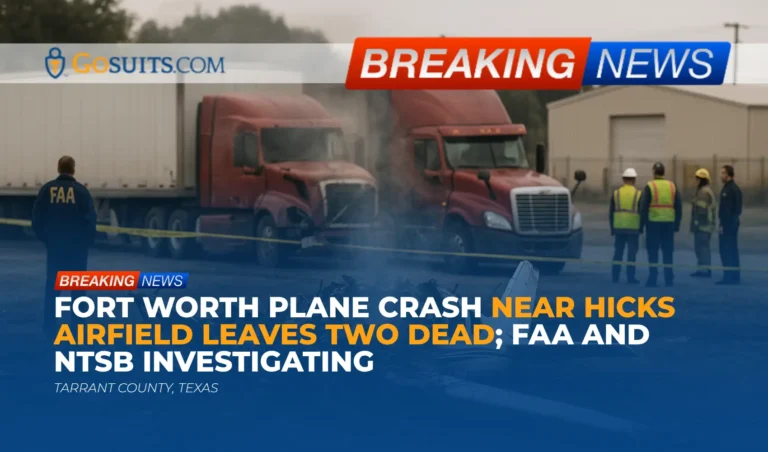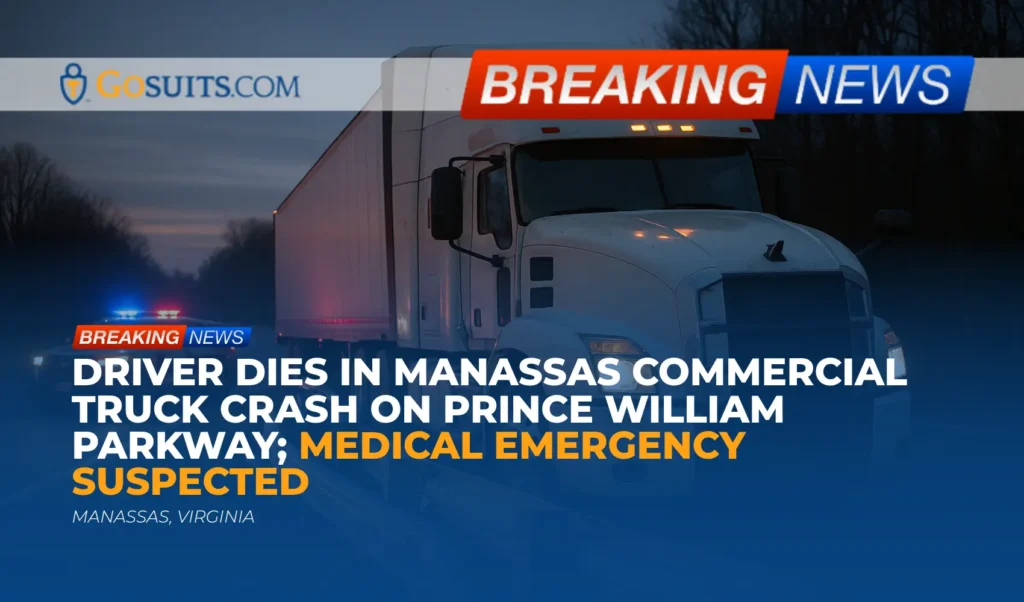- What we know so far about the Tarrant County plane crash
- Location context and community impact
- How aviation crash investigations work in the United States
- How to obtain official records and documents
- Understanding Texas civil remedies after a fatal aviation incident
- Possible civil liability in an airplane collision that causes ground damage
- Insurance considerations after an aviation crash
- Preserving evidence and protecting a claim
- Safety reflections for communities near airfields
- Why acting promptly matters after an aviation incident
- Commentary from Gosuits Fort Worth, Texas Personal Injury Attorney
What we know so far about the Tarrant County plane crash
Authorities reported that two people died after a plane crash in the 12000 block of North Saginaw Boulevard in Tarrant County on Sunday afternoon. The crash occurred near Hicks Airfield, in an area situated between Fort Worth Alliance Airport and Fort Worth Meacham Airport, west of Dallas Fort Worth International Airport. According to initial statements, the aircraft struck 18 wheelers and trailers, and a fire started that has since been brought under control. Multiple public safety agencies responded, including resources from Fort Worth and neighboring communities. At the time of reporting, officials had not yet identified the victims or confirmed the plane’s point of origin. The Federal Aviation Administration is taking the lead in the investigation, and additional updates are expected as facts are confirmed.
This brief summary reflects early information. Aviation investigations proceed in stages and can evolve as agencies collect wreckage, witness statements, radar data, and maintenance records. Families and community members often face a difficult wait during this process. It is appropriate to seek updates from official sources and to be cautious with unverified claims circulating online.
Location context and community impact
The crash location sits near a cluster of aviation activity in North Fort Worth, with Hicks Airfield nearby and two larger airports, Fort Worth Alliance and Meacham, in the region. In areas with active general aviation traffic, there can be additional safety planning for both flight operations and people and businesses on the ground. When an aircraft impacts vehicles or trailers, the incident can affect more than those on board. It may involve property owners, truck operators, warehouse tenants, and nearby roadway users.
In the immediate aftermath, first responders focus on life safety, fire suppression, and securing the site. After the fire is out and hazards are stabilized, federal and local authorities begin evidence preservation and scene documentation. Because this crash involved a fire, the availability of useful physical evidence can be influenced by heat and impact forces. That makes timely documentation by investigators important, including photographing vehicle positions, trailer placements, and any surveillance cameras that may have captured relevant footage.
How aviation crash investigations work in the United States
Roles of the NTSB and FAA
Two federal agencies typically participate after an aircraft accident. The National Transportation Safety Board conducts the independent safety investigation that determines the probable cause. The Federal Aviation Administration focuses on regulatory compliance, immediate safety hazards, and airspace matters. The NTSB describes its process publicly, including on-scene work, laboratory analysis, and the publication of preliminary and final reports. Preliminary reports are often issued within weeks, while final reports can take a year or longer depending on complexity. See the NTSB overview of the investigation process at NTSB Investigations Process.
Reporting and notification obligations for aircraft accidents are codified in federal regulation. The NTSB’s rules for when and how accidents must be reported are found in 49 CFR Part 830, which is available on the government’s eCFR website at 49 CFR Part 830. These rules define what constitutes an accident, immediate notification requirements, and the preservation of wreckage and records.
What to expect in the first weeks
In many cases, an investigator will document the site, arrange for secure wreckage storage, interview witnesses, review radar and flight tracking information, and request maintenance and pilot records. The NTSB typically releases a preliminary report with factual information, not conclusions, within a few weeks. The final report, including the probable cause, may take 12 months or more. While the NTSB investigation is distinct from any civil claim, the factual docket they publish later can be important evidence for families seeking answers. The searchable data portal can be accessed at NTSB Data.
Access to the wreckage and records
Federal regulations give investigators authority to control access to the wreckage until it is released. After release, wreckage is usually returned to an owner or insurer. During the active investigation, parties outside the official process typically cannot inspect the wreckage without approval. The NTSB explains these access and release practices in its public materials about the investigation process at the link above.
How to obtain official records and documents
It is common to feel overwhelmed by the number of agencies and documents involved. Below is a practical guide to records that may exist, where they are usually kept, and how to request them. Each agency follows its own timelines and privacy rules.
Incident, fire, and response records
- Fort Worth Fire Department incident reports. Fire departments often maintain run reports, incident narratives, and hazardous materials records for significant events. The City of Fort Worth processes public information requests under the Texas Public Information Act. Guidance on the Act for the public is available from the Office of the Attorney General at Texas Public Information Act. Fort Worth Fire Department information is available at City of Fort Worth Fire Department.
- Dispatch logs and 911 audio. In Texas, many dispatch records are public, with certain redactions for privacy. Requests are made through the city’s public information process. The availability of 911 audio may depend on retention schedules and ongoing investigations. The Texas Attorney General’s guidance linked above explains what information is typically public.
- Mutual aid agencies. Because multiple departments responded, separate reports may exist with Tarrant County or nearby jurisdictions. Their websites typically provide instructions for open records requests.
Law enforcement crash materials
- Police incident reports. When a police agency assists at an aviation crash, it usually creates an incident report and may collect witness statements or traffic control logs. Request procedures follow the Texas Public Information Act. If Fort Worth Police or Tarrant County Sheriff’s Office assisted, their records divisions can provide instructions for requesting available documents under state law.
Medical examiner and vital records
- Autopsy and examination records. In Tarrant County, the Medical Examiner’s Office manages postmortem examinations and releases. Information about reports, next of kin communications, and obtaining copies is available at Tarrant County Medical Examiner.
- Death certificates. In Texas, certified death certificates are issued through the Department of State Health Services Vital Statistics Section and through local registrars. Guidance is available at Texas DSHS Death Records.
Federal aviation records
- FAA aircraft registry information. The FAA’s public registry provides details about aircraft ownership, registration, and airworthiness certificates. Once the tail number is known, information can be searched at FAA Aircraft Inquiry.
- NTSB documents. As the investigation progresses, the NTSB’s public docket may include photographs, witness summaries, maintenance records supplied to investigators, and technical reports. These are accessed through the NTSB’s data portal at NTSB Data.
How to make a Texas public information request
Texas law gives the public a right to governmental records with limited exceptions. Requests do not need special language but should describe the records clearly. The Attorney General’s office explains how to submit a request and what to expect at What information is public in Texas. Be aware that agencies can require time to process, and some records may be withheld or redacted if they relate to an active investigation or protected personal information.

Understanding Texas civil remedies after a fatal aviation incident
Texas law recognizes distinct civil claims when a person is fatally injured by a wrongful act or neglect. Families often encounter two related but separate legal pathways. These laws are intended to provide a civil avenue for accountability and compensation for harm, independent of any regulatory or criminal proceedings.
Wrongful death claims
Texas permits certain family members to bring a wrongful death action. Eligible beneficiaries typically include the surviving spouse, children, and parents. The wrongful death statute is found in Chapter 71 of the Texas Civil Practice and Remedies Code at CPRC Chapter 71. A wrongful death claim focuses on the losses suffered by those family members, such as loss of companionship and financial contributions, subject to the statute and case law.
Survival claims
Texas also permits a survival action on behalf of the decedent’s estate when the decedent could have brought a personal injury claim if they had lived. This is governed by Section 71.021 of the Civil Practice and Remedies Code, which is included in the same chapter at CPRC Chapter 71. A survival claim addresses damages the decedent suffered before death. The personal representative or administrator of the estate commonly brings this claim.
Statute of limitations
Texas generally imposes a two year limitations period for wrongful death and most personal injury actions, measured from the date of death or injury, with exceptions in specific circumstances. The statute is located at CPRC Section 16.003. Limitations issues can be complex when multiple jurisdictions or federal regulations intersect with a claim. Timely legal guidance helps ensure deadlines are identified and preserved.
How federal investigations relate to civil claims
Federal safety investigations by the NTSB are not designed to decide civil liability. They develop factual information and determine probable cause for safety purposes. Much of the factual record can later be used in civil litigation, though the NTSB’s probable cause statement is generally inadmissible to prove fault. Understanding the difference helps families plan for both the official investigation and any civil case they may consider. The NTSB explains its public investigation materials at NTSB Investigations Process.
Possible civil liability in an airplane collision that causes ground damage
Each aviation event is fact specific. With limited early information in this incident, it is not appropriate to draw conclusions about fault. Below are general categories that often arise in low altitude or approach phase crashes that involve ground impacts near an airfield. These categories are offered to help families understand the range of issues that investigators and insurers often analyze.
- Pilot decision making and operation. Investigations often evaluate weather, airspeed, altitude, approach path, communications, checklists, and potential emergencies aboard the aircraft.
- Aircraft owners and operators. The registered owner or the operator of the aircraft may be different parties. Responsibility can include maintenance schedules, repairs, airworthiness directives, and oversight of pilot training or currency. FAA registration records can help identify ownership, found at FAA Aircraft Inquiry.
- Maintenance providers. Maintenance shops and mechanics have duties related to inspection, repair, and parts installations. Records can be critical to determine whether any maintenance issues contributed.
- Manufacturers and parts suppliers. In rare cases, product liability questions arise, such as design or manufacturing defects. These claims often require detailed engineering analysis and coordination with federal investigators.
- Airfield and premises considerations. If an impact occurs on or adjacent to airport property, investigators may review obstacles, signage, lighting, and traffic management policies.
- Ground parties. When an aircraft strikes parked trailers or trucks, insurers will consider whether any ground conduct played a role. Often the aircraft’s flight path and performance are the central focus, but scene layout and traffic control can be reviewed.
Texas uses proportionate responsibility rules in civil cases, which can affect how damages are allocated among multiple parties if fault is shared. How these rules apply depends on the facts and the evidence developed.
Insurance considerations after an aviation crash
Multiple insurers may become involved quickly after an aviation crash that causes fatalities and ground damage. Insurance companies often deploy adjusters and consultants early, including property, liability, and sometimes excess carriers. Understanding the coverage landscape helps reduce surprises.
- Aviation liability coverage. Aircraft owners and operators commonly carry liability policies that address bodily injury and property damage to third parties. Policies vary in limits and exclusions.
- Hull coverage. This covers damage to the aircraft itself and is usually distinct from liability coverage.
- Excess and umbrella policies. Larger losses can trigger additional layers of coverage above a primary policy’s limits.
- Commercial property and motor carrier insurance. If 18 wheelers, trailers, or a business yard were damaged, trucking and property insurers may also be involved. Their interests may not align with families who lost a loved one.
Insurance representatives sometimes request recorded statements or medical and financial documents soon after an event. Speaking to an insurer before consulting with counsel can affect a later claim. What a person says to an insurance company may be used against them. It is generally wise to consult a qualified attorney first to understand rights, coverage, and the best way to communicate.
Preserving evidence and protecting a claim
Evidence preservation is one of the most time sensitive needs after an aviation crash. Much of the federal wreckage is secured by investigators, but important additional evidence can exist outside of the wreckage. Timely steps can help.
- Scene and surveillance footage. Businesses along North Saginaw Boulevard, nearby warehouses, or highway cameras may have footage that overwrites in days. Preservation letters should be sent quickly to potential custodians.
- Vehicle and truck data. Many 18 wheelers have external cameras and telematics. Written notice to motor carriers to preserve relevant data is important.
- Witness information. Early outreach to identify and document witness accounts can protect accuracy before memories fade.
- Medical and funeral records. Keeping organized records of expenses and services helps with later documentation in a civil claim.
- Coordination with federal investigators. The NTSB controls access to wreckage until release. Families and their representatives can monitor the public docket and request opportunities to review materials after release, consistent with NTSB rules outlined at NTSB Investigations Process.
Because Texas has a two year limitations period for many civil claims as outlined at CPRC Section 16.003, timely action is important. There may also be shorter notice requirements when governmental entities are involved or for certain insurance policy conditions.
Safety reflections for communities near airfields
Communities next to airfields experience both the benefits of aviation access and the risks associated with takeoffs, approaches, and pattern traffic. Federal regulations and airport planning documents often address obstacle management, runway protection zones, and compatible land uses near airports. While it is too early to link any specific planning factor to this crash, it is appropriate for stakeholders to review whether signage, traffic patterns, and emergency access routes remain adequate for current conditions.
General aviation accident trends can inform prevention discussions. The NTSB provides national data that shows fluctuations in accident and fatal accident counts year to year. The agency’s safety reviews and trend data are available at NTSB Data. These resources, along with FAA safety initiatives, support ongoing education for pilots and community awareness for those living and working near airports.

Why acting promptly matters after an aviation incident
Time affects nearly every part of an aviation case. The following steps explain practical actions and why they matter. These points are general and do not depend on any single fact pattern.
- Clarify who will manage affairs. Designating a point person to receive agency calls, organize documents, and coordinate with funeral providers avoids missed deadlines and duplicate requests.
- Secure official documents early. Requesting the medical examiner’s report, certified death certificates, and any available incident records early can prevent administrative delays that complicate insurance claims and estate matters.
- Preserve outside evidence. Business video systems and truck telematics often auto delete within days or weeks. Prompt preservation notices increase the chance that critical footage is saved.
- Be cautious with insurer communications. Insurance adjusters may seek quick recorded statements. A statement made without full information can constrain future options. Consulting a seasoned attorney before speaking with any insurer helps protect rights.
- Calendar legal deadlines. Texas limitations and any notice of claim requirements continue to run while investigations proceed. Tracking these deadlines prevents unintentional forfeiture of claims.
- Monitor the federal investigation. Subscribing for updates and checking for the NTSB preliminary report provides clarity about what facts are public and when more information will be available.
- Protect well being. Grief and trauma after sudden loss can be overwhelming. Gathering supportive family, faith, and counseling resources can help with the emotional demands that accompany administrative and legal tasks.
Commentary from Gosuits Fort Worth, Texas Personal Injury Attorney
Our hearts are with everyone affected by the plane crash near Hicks Airfield. Lives have been lost, families are grieving, and a community is processing a sudden tragedy. This commentary is meant to offer general information about the investigative process and civil considerations. It is not a substitute for individualized guidance.
Based on what is publicly shared, federal investigators will work to understand the aircraft’s flight path, condition, and any operational challenges. Ground impacts involving trucks and trailers introduce additional layers of evidence that can assist in reconstructing events, including surveillance footage, vehicle data, and the physical layout of the area. It is too early to draw conclusions about fault. A careful, methodical review of federal findings and independent evidence will be essential before anyone can responsibly discuss responsibility.
In cases like this, insurers and corporate representatives often move swiftly. They may seek statements, authorizations, or quick settlements before a full picture is available. Large organizations are familiar with the claims process and sometimes rely on the fact that people in grief may not know what they do not know. Documents can be framed as routine or urgent when they shift risk away from the insurer. Speaking with an attorney first can help level the playing field, ensure communications are appropriate, and prevent the release of information that could be used to minimize a valid claim later.
Early legal consultation, at no cost, can provide clarity about next steps without any obligation. A short conversation can help identify time sensitive tasks, explain how the NTSB process intersects with a civil claim, and outline how to obtain key records like the medical examiner’s report or city incident records. That kind of guidance can reduce stress while agencies continue their work.
Where to get official help and information
- NTSB investigation updates. The NTSB publishes preliminary and final reports and maintains public dockets. Overview and access are available at NTSB Investigations Process and NTSB Data.
- FAA aircraft registry. Ownership and registration details can be searched by tail number at FAA Aircraft Inquiry.
- Medical examiner. The Tarrant County Medical Examiner provides information for families and record requests at Tarrant County Medical Examiner.
- City fire and incident records. The City of Fort Worth handles public information requests under the Texas Public Information Act. Fort Worth Fire Department information is at City of Fort Worth Fire Department, and general public information guidance is outlined by the Texas Attorney General at Texas Public Information Act.
- Texas statutes. Wrongful death and survival remedies are explained in the Civil Practice and Remedies Code, Chapter 71, at CPRC Chapter 71, and the limitations statute is at CPRC Section 16.003.
As the investigation progresses and more facts are confirmed, families deserve both clear answers and space to grieve. The civil justice system and the federal safety system serve different purposes but can work in tandem to bring accountability and to prevent future harm. Steady, compassionate guidance can make a difficult process more manageable while decisions are made with care and full information.






